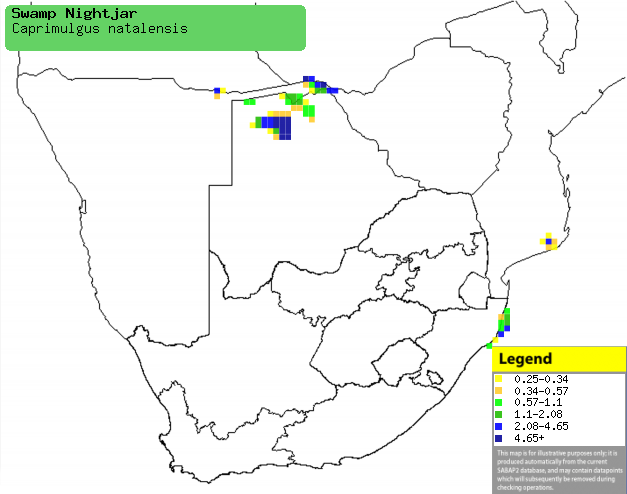|
Caprimulgus natalensis (Swamp
nightjar, Natal nightjar)
Natalse naguil [Afrikaans]; umHlohlongwane [Zulu];
Rumbamba (generic term for nightjar) [Kwangali]; Leubauba, Mmapheke, Tshogwi
(all 3 are generic terms for nightjar) [Tswana]; Moerasnachtzwaluw [Dutch];
Engoulevent du Natal [French]; Natalnachtschwalbe [German]; Noitibó do Natal
[Portuguese]
Life
> Eukaryotes >
Opisthokonta
> Metazoa (animals) >
Bilateria >
Deuterostomia > Chordata >
Craniata > Vertebrata (vertebrates) > Gnathostomata (jawed
vertebrates) > Teleostomi (teleost fish) > Osteichthyes (bony fish) > Class:
Sarcopterygii (lobe-finned
fish) > Stegocephalia (terrestrial
vertebrates) > Tetrapoda
(four-legged vertebrates) > Reptiliomorpha > Amniota >
Reptilia (reptiles) >
Romeriida > Diapsida > Archosauromorpha > Archosauria >
Dinosauria
(dinosaurs) > Saurischia > Theropoda (bipedal predatory dinosaurs) >
Coelurosauria > Maniraptora > Aves
(birds) > Order: Strigiformes > Family: Caprimulgidae
Distribution and habitat
Occupies patches of sub-Saharan Africa, largely excluding
the lowland forest of the DRC and West Africa. Within southern Africa it
is uncommon to locally common in the Caprivi Strip (Namibia), northern Botswana,
eastern KwaZulu-Natal and southern Mozambique. It generally prefers grassland
adjacent to swamps, lagoons, vleis and rivers, as well as mosaics of grass and
reeds (Phragmites), flood plains and grassland with scattered Lala
palms (Hyphaene coriacea).
|
 |
|
Distribution of Swamp nightjar in southern Africa,
based on statistical smoothing of the records from first SA Bird Atlas
Project (©
Animal Demography unit, University of
Cape Town; smoothing by Birgit Erni and Francesca Little). Colours range
from dark blue (most common) through to yellow (least common).
See here for the latest distribution
from the SABAP2. |
Movements and migrations
Resident and largely sedentary, although it may
local movements in response to changing water levels.
Food
Mainly eats insects, doing most of its foraging at dusk,
flying up from the ground to hawk a prey item before returning to the same spot. The following food items have been recorded
in its diet:
Breeding
- Monogamous, territorial solitary breeder, laying two eggs on bare sand,
clay or flattened grass, often adjacent to a grass tuft.
- Egg-laying season is from August-December.
- The eggs are incubated by both sexes for about 20 days, with the female
taking the day shift while the male incubates at night.
- The chicks are brooded until they leave the 'nest' at about 7-9 days
old, relying on their extraordinarily effective camouflage as protection
from predators. They are fed by both parents, who may perform distraction
displays if they are spotted by a predator.
Threats
Not globally threatened, but it is Vulnerable in
South Africa due to the spread of agriculture and development, and the burning of
habitat.
References
-
Hockey PAR, Dean WRJ and Ryan PG 2005. Roberts
- Birds of southern Africa, VIIth ed. The Trustees of the John Voelcker
Bird Book Fund, Cape Town.
|
